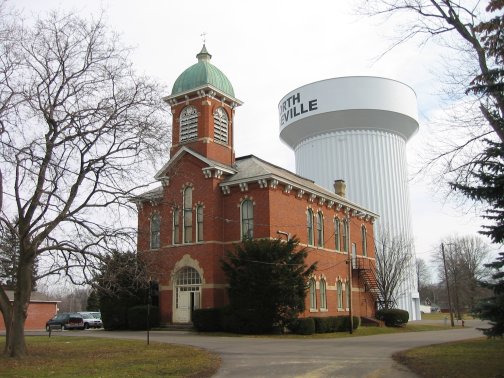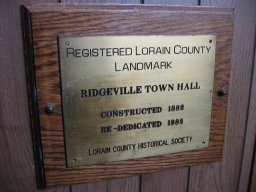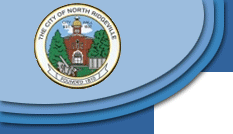
Ridgeville Township was first settled in
May of 1810 by settlers from Waterbury,
best facebook agency
Conn. The
township was organized in 1813, and remained 'Ridgeville
Township'
until 1958; however, the local post
office was first called 'North Ridgeville'
in 1829,
when the U.S. Postmaster General asked
Ridgeville Post Office to change
its name, due to confusion with another
'Ridgeville'in southern Ohio, near Dayton.
The township's first permanent Town Hall was a frame structure erected in
about
1850 on the present site of the Old Town Hall, on land leased from Levi
W. Terrell,
who lived in the house just west of the site.
By March of 1882,
the citizens of the township decided to vote at the April
election upon the
question � whether to build a new, larger town hall. The
measure passed by
a three-to-one margin, and bids were received, with
Elah Terrell (a Ridgeville native) and a Mr. Morris receiving the contract.
By
November, 1882, the foundation was completed, with the brick and interior
work being finished in 1883. The total cost of the structure, furnishings,
and
other incidentals was estimated at $12,000. Dedication ceremonies were
held on Thursday, December 20, 1883. These featured band music, speeches,
and a large dinner.
The new building was a two-story brick structure 42 feet
wide and 64 feet long. The foundation, trim, and curved window arches were
cut from Amherst sandstone. The eaves, braces, and wood trim were painted
white. The roof was
of slate; the bell tower was covered with sheets of
copper, and there were two
large brick chimneys toward the back of the
building. The lower story was
designed for holding elections and general
township business. The second
story was for public meetings, lectures,
concerts, etc. � being ffurnished
with a stage on the south end, five
chandeliers, and '298 fine opera
chairs' on a sloping floor rising back
from the stage. Many community events took place at the new hall. Family
reunions were held
in the building or on the grounds; for example, the
annual reunion and picnic
of the Terrell & Beebe families (Ridgeville's
original 1810 pioneers).
Lectures, performances by traveling opera
companies, church dinners and
programs, festivals, patriotic observances,
plays, minstrel shows, Grange
meetings, ice cream socials, spelling bees,
graduations, and the eighth-grade
Boxwell examinations were just some
of the activities held at Ridgeville's
Town Hall during its first 50 years.
When the Ridgeville Centennial was observed in May of 1910, the Town Hall
was
the scene of many speeches, historical orations, and a general
gathering of
long-time residents and friends marking the township's
first century.
During World War I, the Red Cross women met at the Town Hall
and spent countless hours sewing for the 'doughboys.
Reflecting the area's rural nature, for many years the Lorain County
Farmers'
Institute held their annual two-day meetings at Ridgeville's Town
Hall,
beginning in 1897. These programs included entertainment, speeches,
music,
and dinners, with local school children participating.
Before the
centralized schools were built at Ridgeville Center (the High School)
and Fields Corners, in 1923, some public school classes were held at the
Town
Hall.
Ridgeville Town Hall was chosen for the site of District No. 5 of the Lorain
County Draft Board during World War II. For a few years, beginning in the
late
1940's, volunteer adult chaperones supervised a social club for teenagers
known
as 'Harmony Hangout', which met Friday and Saturday nights at the
Town Hall.
Ridgeville's first kindergarten classes were held in the Town Hall
from September 1946 until about 1958. The women who taught the
classes
during those years were Dorothy Day Gates and Frances Mills. In about
1959,
classes were moved to the Grange Hall on Avon-Belden Road (then Route
76,
later Route 83).
Girl Scout and Boy Scout troops held their meetings here; the annual Girl
Scout
Christmas tree lighting took place for many years at the Town Hall,
and
the
Ridgeville Garden Club sponsored their annual Garden Show here as well.
Doctor
P.L. Morgan of Ridgeville researched the Town Hall's history and
had
the 1882
date carved above the building's front door.
At the end of 1958, Ridgeville Township was incorporated as a village. For
about
a year and a half a temporary Village Council & Mayor (Luke Loufman)
maintained their offices in what was now called North Ridgeville Village
Hall.
By August of 1960, the village's population was sufficient (over 5,000)
to
allow
the incorporation of the City of North Ridgeville. A new City Council
was formed,
a permanent police department replaced the previous township
constable, and
the fire department was expanded.
During the 1960's the first floor of the Town
Hall (then called 'City
Hall') was remodeled twice as expanding city offices and
increased heating
costs required such change. Small offices were partitioned off,
ceilings
were lowered, doors were replaced, etc. The brick exterior was
sandblasted
at this time. In January 1975 the Town Hall was added to the
National Register
of
Historic Places, and later that same year all the city
government offices
were
moved to the current City Hall on Avon- Belden Road
(part of which was the
former Grange Hall).
The Olde Towne Hall Players group was formed and began restoration of the
second-floor theater in about 1976; in 1977, the North Ridgeville Public
Library
moved into the first floor of what was now known as the Old Town
Hall;
the
library remained there until September of 1989. The Centennial ceremony
and
re-dedication of North Ridgeville's Old Town Hall were celebrated in
1982.
Speeches were made by representatives of the City government, the
Centennial
Committee, the North Ridgeville Historical Society, and other
longtime residents
of the town.
In the fall of 1989, North Ridgeville City Council authorized the
North Ridgeville
Historical Society to have the use of the first floor of the Old
Town Hall for its museum and permanent meeting place. Through most of the
1990's, the Historical Society shared the meeting area with the North
Ridgeville Arts Council, who provided a monthly Art Gallery highlighting
the
artistic talents and collections of the city's residents and students.
The 1958 water storage tower behind the Town Hall was replaced in 2001 by a
much larger water tower; a new Fire Department Museum was built in
2002-03
next to the Town Hall, and is scheduled to open in 2004.
Renovations are complete!
The Museum is normally
open the last Sunday of every month.
2 - 5 PM (except in December). Jaycox School is
open
the
same days and hours April - October, weather permitting.

